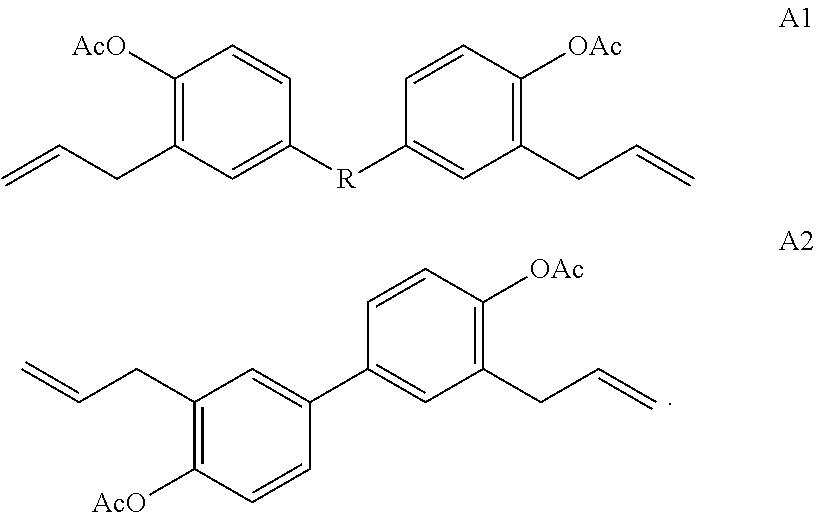Methods of making stable and thermally polymerizable vinyl, amino or oligomeric phenoxy benzocyclobutene monomers with improved curing kinetics
a technology of phenoxy benzocyclobutene and stable polymerizable vinyl, which is applied in the field of making monomer materials, can solve the problems of low monomer yield (70%) of unstable monomer compounds, unsuitable for use with many polymer or plastic materials, and unsuitability for applications
- Summary
- Abstract
- Description
- Claims
- Application Information
AI Technical Summary
Benefits of technology
Problems solved by technology
Method used
Image
Examples
example 2
Preparation of Vinyl Phenoxy Benzocyclobutene
[0071]In a 250 ml three necked round bottom flask equipped with a polytetraflouroethylene (Teflon™ polymer, Dupont, Wilmington, Del.) coated magnetic stir bar, potassium hydroxide (1.38 g, 1 eq) was dissolved in water (6.83 g). Then 4-acetoxy styrene (4 g, 1 eq) was added dropwise at room temperature, and the solution turned from colorless to pale orange. Potassium carbonate (6.82 g, 2 eq) was added portionwise, and the solution was stirred for one hour. The flask was equipped with a reflux condenser, then 1-bromobenzocyclobutene (4.06 g, 1 eq) was added dropwise in DMF (41 ml). The solution was then heated to 70° C. and allowed to reflux overnight. To the reaction was added water (50 ml) and ethyl acetate (50 ml). The aqueous residue was extracted four times with ethyl acetate (100 ml). The combined organics were extracted with sodium bicarbonate solution (1×100 ml), lithium chloride aqueous solution (1×100 ml) and brine (2×100 ml). The ...
example 3
Preparation of Vinyl Phenoxy Benzocyclobutene
[0072]To a 3 L three neck reaction flask fitted with mechanical stirring (300 rpm), a glass additional funnel and a thermocouple was added acetoxystyrene and DMF. The acetoxystyrene was sparged with nitrogen for 15 minutes, then the reactor was submerged in an ice bath to which the thermocouple read 15° C. A solution of sodium methoxide in methanol (NaOMe / MeOH) was fed into the glass addition funnel, and the solution was added portion-wise over 60 minutes, monitoring the exotherm (highest T was 21° C.). When addition was complete, a wine red solution was observed. 1-BrBCB, DMF and a nitroxide containing radical polymerization inhibitor (TEMPO, 2,2,6,6-Tetramethylpiperidine 1-oxyl, CAS 2564-83-2, 25 mg) were fed into the reactor and stirred for 30 minutes. The ice bath was removed and a heating mantle was applied. The mixture was heated to 70° C. (setpoint, never exceeded 70° C.). The mixture was stirred and tracked by NMR (d6 DMSO or d6 a...
example 8
Preparation of a Copolymer of Vinyl Phenoxy Benzocyclobutene co Styrene
[0079]Styrene (4.77 g) and Vinyl Phenoxy Benzocyclobutene (1.13 g) were dissolved in THF (3.98 g) along with V601™ initiator (70 mg) in an EZ Max™ 100 ml jacketed reactor (Mettler Toledo, Columbia, Md.) equipped with overhead stirring and nitrogen atmosphere. The solution was purged with nitrogen gas for 30 minutes, then heated to an internal temperature of 60° C. overnight. The resulting viscous solution was diluted with THF (20 ml) then precipitated into methanol (250 ml), filtered and dried overnight in vacuo to give the copolymer (4.23 g, 72% yield). Mn 36.6k, Mw 79.1k. The polymer curing kinetics were evaluated via differential scanning calorimetry (DSC, TA Instruments Q2000, TA instruments, New Castle, Del.) at a ramp rate of 2, 5, 10 and 20° C. / min. The Kissinger method was used to determine a ring opening activation barrier of 24.2 kcal / mol. Thermal stability was evaluated using thermogravimetric analysis...
PUM
| Property | Measurement | Unit |
|---|---|---|
| temperature | aaaaa | aaaaa |
| temperature | aaaaa | aaaaa |
| temperature | aaaaa | aaaaa |
Abstract
Description
Claims
Application Information
 Login to View More
Login to View More - R&D
- Intellectual Property
- Life Sciences
- Materials
- Tech Scout
- Unparalleled Data Quality
- Higher Quality Content
- 60% Fewer Hallucinations
Browse by: Latest US Patents, China's latest patents, Technical Efficacy Thesaurus, Application Domain, Technology Topic, Popular Technical Reports.
© 2025 PatSnap. All rights reserved.Legal|Privacy policy|Modern Slavery Act Transparency Statement|Sitemap|About US| Contact US: help@patsnap.com



